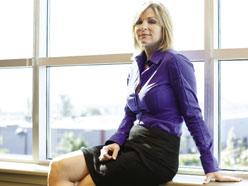
Christine LaLiberté,
CIM, FCSI, is senior investment advisor, director, private client group at DundeeWealth (renamed HollisWealth as of November 2013). Her clients are mostly business owners, retirees or those nearing retirement. About 70% of her clients are between ages 55 and 70.
In 2008, when most advisors were scrambling to maintain their businesses, Christine LaLiberté of DundeeWealth was doubling her AUM.
Since then, she’s increased it another $40 million and today it stands at $110 million. LaLiberté says her revenue continues to rise 10% to 15% annually.
How did she do it? With a client profiling process that integrates risk management, tax and estate planning, and investment counseling.
“A lot of advisors get on the phone and start cold calling, try to get clients to bring in more money, or advertise their services,” she says. “But since creating this process, we’ve had the phone ring each week with client referrals. We never have to market ourselves.”
In 2006, LaLiberté realized her business wasn’t growing. Instead of hosting yet another seminar, she looked at how she served clients.
“All I did in meetings was bring in blank paper. Their statements and the focus of everything we did was around their investments,” she says. “But our job is much more extensive than just investments.”
She knew it was time to make over the way she approached her client base.
“I’d been to many seminars, paid for mentoring programs and gathered bits and pieces of information, ideas and strategies,” LaLiberté recalls.
The breakthrough came when she connected those pieces.
“I put it all together in one document. It started small and has developed into a 16-page document dubbed the Personal Financial Action Plan (PFAP).”
This file is presented to each new client. And two hours are spent during the initial meetings filling it out. Details include: contact information, long- and short-term goals, savings plans, assets, debts, wills and trusts, and insurance.
Follow-up meetings can take an hour and a half. Top clients have these meetings twice a year and the next tier gets them annually. They discuss changes to finances, life events and investments; all that data serves to update the PFAP. And at the end of the meeting, she provides clients with homework: If a client doesn’t have a will, she refers him to a lawyer and provides a deadline to complete one.
She adds investments are the last topic of discussion. “A lot of advisors create those documents initially, and when the clients come on board that’s the last time they’ll see anything on paper. There is no follow-up on strategies. Instead, conversations revolve purely around investments.”
This is why her process differs. For instance, LaLiberté recently helped a referral client save money. She steered the conversation away from investing and instead discussed the client’s life situation and finances (see “Client solutions,” right).
To find time for such thorough meetings, LaLiberté’s had to pass some clients—those with fewer assets or who weren’t as interested in planning—to other advisors looking to build their books.
She’s also added staff. Her team of four includes an associate advisor, branch administrator, insurance advisor and reception/client relations manager.
It wasn’t easy
LaLiberté spent most of 2007 creating and introducing her process to existing clients. As a result, her business took a hit because she didn’t have time to chase prospects.
“A lot of the workload fell on me because I didn’t have as big a team,” she recalls. “I remember falling asleep on my laptop at home.”
She knew she had to hire help, even though she wasn’t sure she could cover their salaries. And, at first, she couldn’t. “I had to take a pay cut just so I could pay my staff,” she says.
Once the process was fully implemented, her practice recovered. LaLiberté continues to receive referrals weekly—she got about $10 million in unsolicited assets last year. And clients are so pleased with her service they often hug her.
She’s also been asked to speak on stage at her firm’s annual conference. Following a 2011 presentation, many attendees approached her to get access to the PFAP. So now she spends three weeks a year training others. Last year, she taught six sessions, and this makes up 5% to 10% of her income.
Don’t forget technology
LaLiberté attributes some of her business growth to properly using her CRM.
She says most advisors simply input a client’s name, address and phone number. She ensures the PFAP is tagged electronically to each client file.
Then, there’s contact management. LaLiberté used to call her top clients every six months, which meant that every January and June, she’d print a list with about 40 numbers on it.
“That’s 40 calls I’d have to make in a couple days,” she says, “and that task usually got buried because it seemed overwhelming.”
Now, she staggers the calls. Each file has a reminder when it’s time to call, and they’re spaced out to make it manageable. Top clients receive an account review every four months and a face-to-face every six months.
“I now have maybe 10 to 12 client calls per month—not 40, two times a year,” she says.